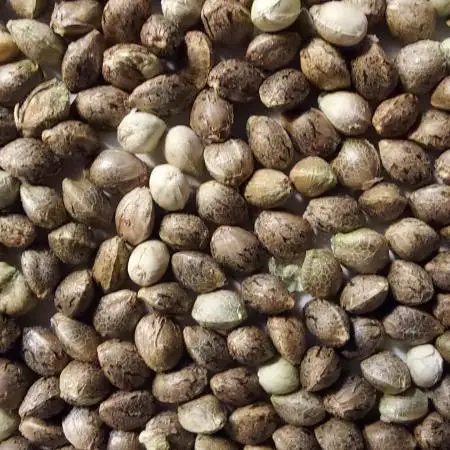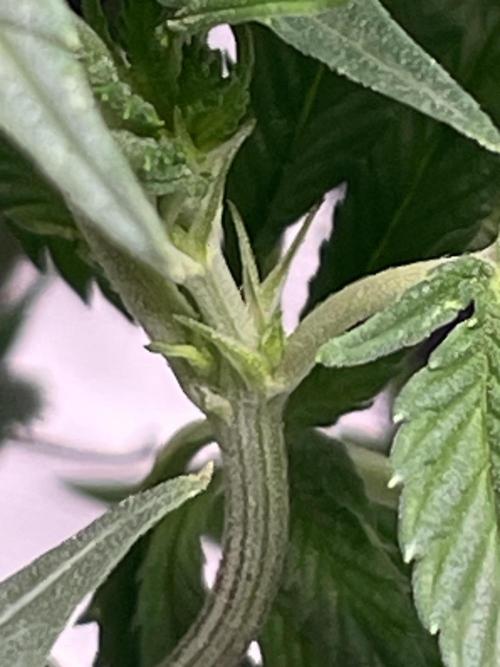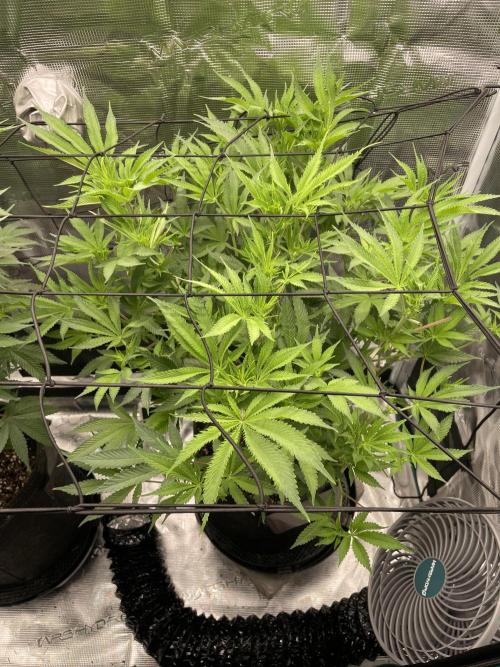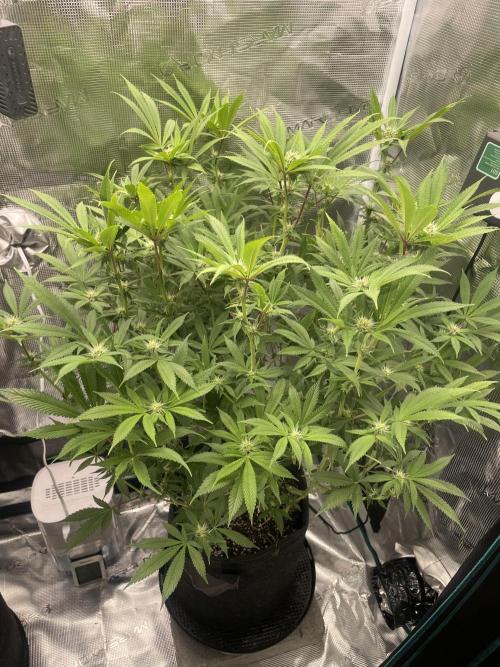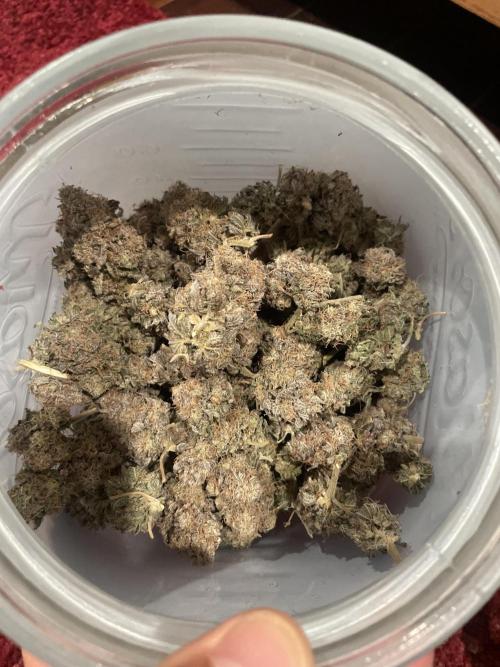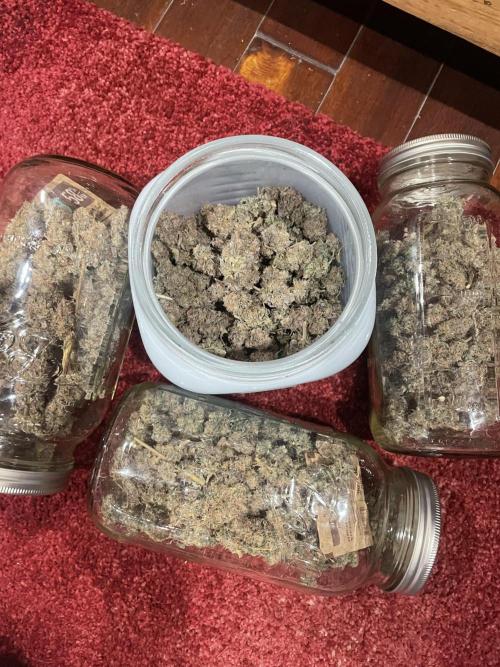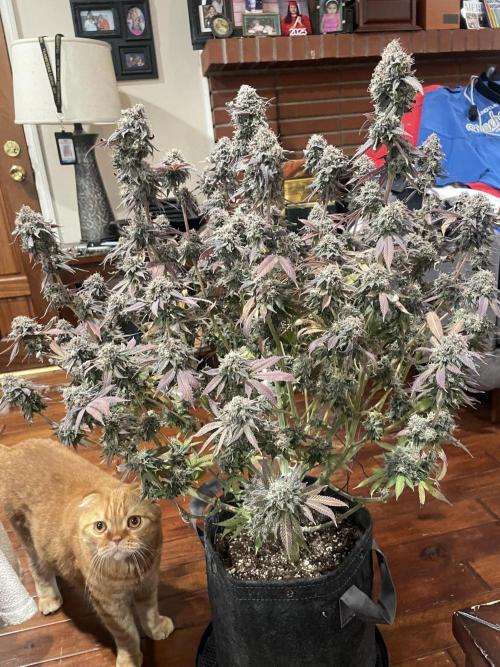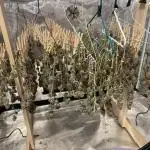The Grow Awards 2026 🏆 



Donny Burger 1st

Donnie Burger
710 Labs
Soil
Indoor
Room Type
Defoliation
weeks 5-6, 8-9, 11, 13-14
LST
weeks 8, 13-14
11 liters
Pot Size
4 liters
Watering
Start at Harvest
1
Week 1. Vegetation9mo ago
22.86 cm
Height
18 hrs
Light Schedule
26 °C
Day Air Temp
6.2
pH
65 %
Air Humidity
19 °C
Night Air Temp
3 liters
Pot Size
2 liters
Watering Volume
35.56 cm
Lamp Distance
JKRON Week 1 first grow
Following the fox farm soil schedule
Any advice is welcomed
Thanks in advanced!
2 likes
comments
Share
2
Week 2. Vegetation9mo ago
22.86 cm
Height
18 hrs
Light Schedule
26 °C
Day Air Temp
6.2
pH
65 %
Air Humidity
19 °C
Night Air Temp
11.36 liters
Pot Size
2 liters
Watering Volume
35.56 cm
Lamp Distance
JKRON Week 2 what power should I be at 50%
2 likes
comments
Share
3
Week 3. Vegetation9mo ago
25.4 cm
Height
18 hrs
Light Schedule
23 °C
Day Air Temp
6.2
pH
860 PPM
TDS
65 %
Air Humidity
19 °C
Night Air Temp
11.36 liters
Pot Size
2 liters
Watering Volume
50.8 cm
Lamp Distance
JKRON Gonna top them after feeding.
2 likes
comments
Share
4
Week 4. Vegetation9mo ago
10.01 cm
Height
18 hrs
Light Schedule
23 °C
Day Air Temp
6.2
pH
860 PPM
TDS
65 %
Air Humidity
19 °C
Night Air Temp
11.36 liters
Pot Size
2 liters
Watering Volume
50.8 cm
Lamp Distance
JKRON Growing
2 likes
comments
Share
5
Week 5. Vegetation9mo ago
10.01 cm
Height
18 hrs
Light Schedule
23 °C
Day Air Temp
6.2
pH
860 PPM
TDS
60 %
Air Humidity
19 °C
Night Air Temp
11.36 liters
Pot Size
2 liters
Watering Volume
50.8 cm
Lamp Distance
JKRON Gonna top and defoliation today
2 likes
comments
Share
Used techniques
Defoliation
Technique
6
Week 6. Vegetation8mo ago
30.48 cm
Height
18 hrs
Light Schedule
23 °C
Day Air Temp
6.2
pH
Weak
Smell
960 PPM
TDS
65 %
Air Humidity
19 °C
Night Air Temp
11.36 liters
Pot Size
2 liters
Watering Volume
50.8 cm
Lamp Distance
JKRON Flower next week
2 likes
2 comments
Share
Used techniques
Defoliation
Technique
Grow Questions
JKRONstarted grow question 8mo ago
Hello friends,
My lights only at 40% and it’s 20’’ away when should I start increasing power?
Mars claims 12 to 18 and 75% and that cooked them.
Thanks
Solved
2 likes
00110001001001111Oanswered grow question 8mo ago
trial and errorr.
16-20" is usually a good range...when other factors jive well together, hanging distance is best choosen by resulting area of coverage -- how much difference is the central readigns from the readings along the edges - a simple klux app can do this, or you can use an app that converts it to ppf/ppe, but for this endeavour there is no benefit and there is a +/-10% error on that conversion due to variances in LED grow lights.
any light measurement can give you proportional intensity differences from center to edges.. is it 50% of the central reading? is it 66%? are you sacrificing overall average to even out the light?
Their "PAR" maps can help choose hanging distance too.
umol/s of PAR and hours of operation are proportional to resulting DLI. DLI is what matters. "35" DLI is 35 dli regardless of how big the garden is or how many hours the lights operate. Learn about Daily Light Integral and avoid a tone of bad advice, lol. Many people look at one factor without considering the other. This is like miles per hour without duration of travel time.. the distance traveled being an analog to DLI. Rate x time = something useful. One alone is mostly useless.
These are just good starting points. No matter what, your local climate will cause variance. You will always need to observe and react to the plant for fine-tuning adjustments. The developing distance between growth nodes is your guide to adjust the light. Too tight = need less light. Too lanky = need more light. That's how you find "Your" goldielocks zone.
if not intimidated my math, read the DLI wiki page. Check out your umol/s production of the light, assume it's focused on the proper area (hanging distance) and shoot for 35-40 DLI to start. The percent dim should nearly 1:1 correlate with umol/s output.
FC4000
of course mars is now limiting useful information. they don't give umol/s tech details or diode count to verify if they are lying about efficacy... Let's assume they are not lying.
2.85 * 320 watts = 912 umol/s PAR output from the diode.
8ft^2 / 10.764 m^2 = .74 m^2 coverage
912 / .74 = about 1200 PPFD maximum in 8sq ft tent -- actual is less than this due to missing plant or absorbed into walls. That's baked into the suggestion already given typical hanging distances.
This is a shit ton at 100% for 8sq ft (about 52 DLI). Refer to any DLI table to shoot for 35-40 DLI
12h @ 900 ppfd = 38.9 DLI
900 /1200 = 75% -- with ambient co2 conditions, 75% in a 4x2 over 12 hours is as much as you need.
18 hours @ 675 PPFD = 38.9 DLI (1:1 inversely proportional to hours of operation)
600/1200 = 50% -- with ambient co2 conditions, 50% in a 4x2 over 18 hours is as much as you need.
These are starting points... May need slight adjustmennt from there.
Also, unlike their suggestion of 12", i'd go to 15-16" hanging distance, minimum. If you have a poor climate, you may want it even higher or slightly more dimmed. The plant growth will scream it at you eventually.
for 12 hour operation and ambient co2, the max coverage of this light is closer to 11 sq ft as opposed to 8 sq ft. This might be better in a 3x4 space and some room leftover for equipment or avoid contact with walls.
heh, usually mars has better starting suggestions. Their suggestion seems to be based upon 1200-1300ppm of CO2 and not ambient co2. plus, an improper vpd (temp and rh) will result in less potential photosynthesis per day (i.e. lower DLI maximum before damaging/stunting). If you were supplementing CO2 it's well-tailored for a 4x2 area.
more is not better. the right amount is better.
8
Week 8. Vegetation8mo ago
40.64 cm
Height
18 hrs
Light Schedule
23 °C
Day Air Temp
6.2
pH
Weak
Smell
960 PPM
TDS
65 %
Air Humidity
19 °C
Night Air Temp
11.36 liters
Pot Size
2 liters
Watering Volume
50.8 cm
Lamp Distance
JKRON Moving along! Gonna start flower after this week.
2 likes
comments
Share
Used techniques
Defoliation
Technique
LST
Technique
9
Week 9. Flowering8mo ago
50.8 cm
Height
12 hrs
Light Schedule
28 °C
Day Air Temp
6.2
pH
Weak
Smell
960 PPM
TDS
65 %
Air Humidity
21 °C
Night Air Temp
11.36 liters
Pot Size
2 liters
Watering Volume
50.8 cm
Lamp Distance
1400 PPM
CO₂ Level
JKRON Fingers crossed hoping females.
Any suggestions all welcome!
likes
comments
Share
Used techniques
Defoliation
Technique
10
Week 10. Flowering8mo ago
50.8 cm
Height
12 hrs
Light Schedule
28 °C
Day Air Temp
6.2
pH
Weak
Smell
960 PPM
TDS
65 %
Air Humidity
21 °C
Night Air Temp
11.36 liters
Pot Size
2 liters
Watering Volume
50.8 cm
Lamp Distance
1400 PPM
CO₂ Level
JKRON Starting to bud.
1 like
comments
Share
11
Week 11. Flowering8mo ago
50.8 cm
Height
12 hrs
Light Schedule
28 °C
Day Air Temp
6.2
pH
Weak
Smell
960 PPM
TDS
65 %
Air Humidity
21 °C
Night Air Temp
11.36 liters
Pot Size
2 liters
Watering Volume
50.8 cm
Lamp Distance
1400 PPM
CO₂ Level
JKRON Good week of growth
likes
comments
Share
Used techniques
Defoliation
Technique
12
Week 12. Flowering7mo ago
81.28 cm
Height
12 hrs
Light Schedule
31 °C
Day Air Temp
6.2
pH
Weak
Smell
1200 PPM
TDS
65 %
Air Humidity
22 °C
Night Air Temp
11.36 liters
Pot Size
4 liters
Watering Volume
50.8 cm
Lamp Distance
1400 PPM
CO₂ Level
JKRON Had a couple issue some nuke burn so I’m just giving ph water. I think that’s the problem hopefully
1 like
comments
Share
Grow Questions
JKRONstarted grow question 7mo ago
I need your help please!
Whats more important my VPD zone or keeping my RH in the 60's?
My temps are getting to 88f
Thanks
Open
1 like
Answer
00110001001001111Oanswered grow question 7mo ago
Both.
Going over 65% should be avoided. Extremely low or high VPD should be avoided.
What you need to do is get your temperatures down. Consider lights-on at night and dark cycle during the day. Exhausting outside is also an option that may or may not be enough on its own. Grow during cold season, which is what i do. Slim down garden - less light = less heat... all sorts of options including an AC unit, which will also reduce humidity.
An RH% above 65% invites microbial growth. You should also avoid extreme VPD values - low or high. This will cause slow growth.
88F is extreme. Thisi s the root of your problem. Fix that and the rest will fall in line.
likes
Complain
pHilosophy420answered grow question 7mo ago
Yo, at this stage in flower, you don’t wanna be sittin’ at 50–60% RH that’s too humid, especially with high temps.
You really wanna dial it into the 40–50% RH range to keep your VPD in check and avoid bud rot. Late flower is all about drying it out just enough so your buds finish dense and clean. At 88°F, 60% RH throws your VPD off and slows everything down.
Either drop the temp a bit or lower the humidity whatever gets you closer to that 1.2–1.5 kPa sweet spot. That’s the zone where your plants breathe right and stack weight without risking mold. So nah, don’t shoot for 50–60%, stay closer to 40–50% and you’ll finish with dank, tight buds.👊
likes
Complain
Ultravioletanswered grow question 7mo ago
Vpd, vapor (water) pressure deficit (difference) between two atmospheres.
The more optimal vpd the more efficient the plant will drive transpiration, transpiration drives osmosis which creates turgor. High turgor, high cell elongation, high stress, high workload.
Vpd is about rapid growth. Last week or two of ripening is not about rapid growth, I always find terpene profile is at its highest probably 2 weeks prior to trichomes being ready, but that's just my opinion. Last week or two should be lowering rh to ensure a safe finish, high temps come with high humidity, still pushing 85f for last two weeks you will be lucky to have any profile whatsoever. As buds get bigger they become thick, moisture can easily get trapped in 50+rh bringing with it botyris( bud rot) Terpenes start to degrade around 68f and above. It's about finding a balance, any time I tried to push growth hard for last weeks all I end up doing was burning off smell and taste and promoting early CBN production in buds. Buds will be airy the more heat they are exposed to. cannabis buds can be affected by cold temperatures and can experience compression, not going to change drastically but the difference was noticeable.
Good luck 👍
likes
Complain
13
Week 13. Flowering7mo ago
121.92 cm
Height
12 hrs
Light Schedule
29 °C
Day Air Temp
6.2
pH
Weak
Smell
1200 PPM
TDS
64 %
Air Humidity
22 °C
Night Air Temp
11.36 liters
Pot Size
4 liters
Watering Volume
50.8 cm
Lamp Distance
1400 PPM
CO₂ Level
JKRON Starting to frost up and gain some size.
likes
comments
Share
Used techniques
LST
Technique
Defoliation
Technique
14
Week 14. Flowering7mo ago
121.92 cm
Height
12 hrs
Light Schedule
28 °C
Day Air Temp
6.5
pH
Weak
Smell
1200 PPM
TDS
64 %
Air Humidity
22 °C
Night Air Temp
11.36 liters
Pot Size
4 liters
Watering Volume
50.8 cm
Lamp Distance
1400 PPM
CO₂ Level
JKRON Had a PH issue I think I got it sorted out. Molybdenum Deficiency!
likes
comments
Share
Used techniques
LST
Technique
Defoliation
Technique
15
Week 15. Flowering6mo ago
121.92 cm
Height
12 hrs
Light Schedule
28 °C
Day Air Temp
6.5
pH
Normal
Smell
1200 PPM
TDS
60 %
Air Humidity
22 °C
Night Air Temp
11.36 liters
Pot Size
4 liters
Watering Volume
50.8 cm
Lamp Distance
1100 PPM
CO₂ Level
JKRON Week 15 almost there!
likes
comments
Share
16
Week 16. Harvest6mo ago
Happy Harvest Day!
Spent 99 days
Ger Veg Flo Har
176 g
Bud wet weight per plant
2
Plants
20.32 m²
Grow Room size
Normal
Difficulty
Height
Day air temperature
Air humidity
PPM
PH
CO2
Light schedule
Night air temperature
Pot size
Lamp distance
JKRON Waiting for the finish.
1 like
comments
Share
Equipment Reviews

the end.
Enjoying this diary? Follow for more updates!
Prefer the old Diary view?
Go back to the old Diary view















